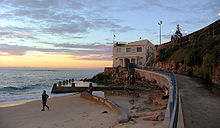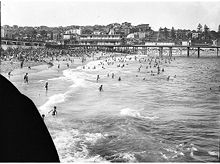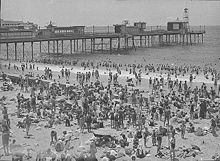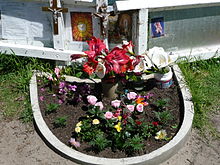- Coogee, New South Wales
-
Coogee
Sydney, New South Wales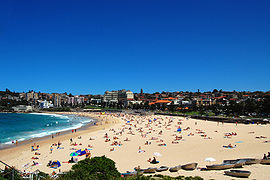
Coogee Beach, view from Dolphin Point at the northern endPopulation: 13,179 (2006) [1] Postcode: 2034 Location: 8 km (5 mi) south-east of Sydney CBD LGA: City of Randwick State District: Coogee Federal Division: Kingsford Smith Suburbs around Coogee: Charing Cross Clovelly Randwick Coogee Tasman Sea Maroubra South Coogee Coogee is a beachside suburb of local government area City of Randwick. It is located 8 kilometres south-east of the Sydney central business district, in the state of New South Wales, Australia. It is also a part of the Eastern Suburbs of Sydney. [2]
The Tasman Sea and Coogee Bay along with Coogee Beach lie towards the eastern side of the suburb. The beach is popular for swimming. The boundaries of Coogee are formed mainly by Clovelly Road, Carrington Road and Rainbow Street, with arbitrary lines drawn to join these thoroughfares to the coast in the north-east and south-east corners.
Contents
History
Aboriginal
The name Coogee is said to be taken from a local Aboriginal word koojah which means "smelly place". Another version is koo-chai or koo-jah: the smell of the seaweed drying (Bidigal language). [3] or "stinking seaweed", a reference to the smell of decaying kelp washed up on the beach.[4] Although at certain times large quantities of seaweed are still washed up, it is usually removed before it gets a chance to stink. Coastal winds can carry the stench to surrounding suburbs and as far westwards as the University of New South Wales.
Early visitors to the area, from the 1820s onwards, were never able to confirm exactly what "Coogee" meant, or if it in fact related to Coogee Beach. Another name, "Bobroi", was also recalled as the indigenous name for the locality.[5]
Some evidence suggests that the word "Coogee" may in fact be the original Aboriginal place name for the next bay to the north, now known as Gordon's Bay.[6]
The Aboriginal population had largely relocated by the mid-19th century after being decimated by disease and violent clashes with early settlers, though some Aborigines still live in the area today.
European settlement
Coogee was gazetted as a village in 1838, in 1863 the first school was built which was later converted to become the Coogee Bay Hotel in 1873, three years later in 1876 Coogee Public School was established. In late 1887, Coogee Palace Aquarium and swimming baths followed by the construction of the Coogee pier in 1928 which was later demolished in 1934.
Coogee was connected to the City of Sydney by electric tram in 1902. The suburb's popularity as a seaside resort was then guaranteed. The line branched from the line to Clovelly at Darley Rd in Randwick. It ran down King St beside the Randwick Tram Workshops, then ran in its own reservation to Belmore Rd. It then ran down Perouse Rd, St Pauls St, Carr St and Arden St before terminating in a balloon loop in Dolphin St at Coogee Beach. It ran through several small tram reservations on its way down from Randwick to the beach. The line from Randwick to Coogee opened in 1883, and electric services were introduced in 1902. The line closed in 1960. It follows the current route of bus 373.
The Coogee Surf Life Saving Club was founded in 1907. Population growth began in earnest in the 1920s. An English-style seaside entertainment pier stood at the beach between 1928 and 1934, but it was demolished after serious damage by the surf.[7]
Built in the early 1890s and occupied by a Mrs T.M. Alcock was a large mansion known as Maidstone, which stands in Waltham Street beside St Brigid's Church.The house features a metal cupola and cedar fittings inside. The Catholic Church bought the building in 1922 and it was restored to its original style by Provincial House of the Missionaries of the Sacred Heart.[7]
Located in Alison Road is a two-storey Federation mansion named Ocean View. The house was built in 1916 by Philip Wirth, of Wirth's Circus[citation needed].
Coogee Palace Aquarium (1887-1986)
The Coogee Aquarium and Swimming Baths were officially opened on 23 December 1887, it covered a block of land bordered by Arden Street, Beach Street, Bream Street and Dolphin Street. The Palace included an indoor Swimming pool (25 x 10 meters), an aquarium featuring the tiger shark from the famous shark arm murder case, a Great Hall that could be used as a roller skating rink, Canadian toboggan ran down the hillside for over 70 meters, a herd of 14 donkeys to ride as well as swings, whirligig's rocking horses, toy boats, aviaries, flower beds, bandstand and an open air bar.
In June 1945, a strong storm caused the large dome to collapse, in 1987 the Coogee Palace and Dome was re-built and converted to restaurants and bars. The current hotel on the premises is owned by investment banker David Kingston and is known both as The Beach Palace Hotel and The Aquarium.
The Coogee Pier (1928-1934)
In 1924 construction started to build an 'English seaside style' amusement pier at Coogee Beach, on 24 July 1928, the pier was officially opened, reaching 180 meters out into the sea complete with a 1400 seat theatre, a 600 capacity ballroom, a 400 seat restaurant upstairs, small shops and a penny (machine) arcade. Unfortunately Coogee's rough surf damaged the pier and it was demolished in 1934. Life guards have recently discovered remains of the pier on the ocean floor about 50 meters out from shore.
Shark Arm Murder Case (1935)
Main article: The Shark Arm CaseThe Shark Arm Case refers to an incident at the Coogee Aquarium Baths in 1935, when a captured tiger shark regurgitated a human arm. The arm belonged to a missing person, James Smith, and was identified by a tattoo. The arm had been cut off, which led to a murder investigation. Nobody was ever charged over the murder, although another local criminal, Reginald Holmes, was found shot in a car near the Sydney Harbour Bridge the day before the inquest into Smith's death was due to start.
Alleged Marian apparition (2003)
In January 2003 it was noticed that one of the fence rails on Dolphin Point, just north of Coogee Beach, when viewed from a particular angle and distance, resembled a veiled woman. A local laundrette was one of the first to draw attention to it, and set up a gallery of photos to attract visiting "pilgrims".
When the illusion was reported in newspapers many Christians (predominantly Roman Catholic) came daily to worship what they interpreted as an apparition of Mary, the mother of Jesus, although the Roman Catholic Church never officially recognised this alleged apparition of the Blessed Virgin Mary.[8]
No particular supernatural powers were attributed to the shadow (dubbed "Our Lady of the Fence Post" by the media, aka "Rail Mary") and interest waned within a few weeks. The section of fence that created the image was destroyed by vandals within days of it being publicised, although the local council had the fence replaced. While some continue to petition the Catholic Church and the New South Wales government to build a chapel, their claims were not seriously considered.
Transport
Sydney's steam tramways first reached Coogee in 1883 and were electrified in 1902. The trams were replaced by buses from time to time in the 1940s and 1950s as the infrastructure suffered severe neglect during and after WWII. The tracks were deemed too expensive to repair and the power supply was so inadequate that trams would grind to a halt in incovenient locations. Eventually the entire Sydney tram network was scrapped and replaced by buses. The last trams ran to Coogee in 1960.
The suburb is now well served by buses, with routes to the Sydney CBD via Randwick, and also to Bondi Junction, Eastgardens via Kingsford and Maroubra and Leichhardt via Glebe and Newtown.
Geography and landmarks
Coogee Bay Road runs from Randwick to Coogee Beach which is relatively protected through its formation as a bay. The surrounding coastline is mostly cliffs, decreasing in height down to the beach in the western part of the bay. The bay is sheltered from the roughest seas by Wedding Cake Island, a rocky reef about 800m off the southern headland. There is an annual swimming event around the island each November.[9]
The beach itself drops off rapidly at the edge of the water, which can result in a dangerous shore break particularly when the surf is large. The combination of this shore break and high visitor numbers mean that Coogee has more spinal injuries than any other Australian beach.
In larger surf, there are often rip currents at both the northern end and at the southern ends, and also quite frequently in the centre of the beach. These are simply the places where the incoming water escapes most naturally. It is claimed by some locals that the rip in the centre of the beach is partly caused by the remaining foundations of the old entertainment pier (see above - history).
At the northern end of the beach are stairs leading from Dolphin Point down to the old Giles baths. This is now an open rock pool carved out of the surrounding rocks. This area is now known as "Dolphin Point". The doorway and a four-metre high bronze sculpture serve as a memorial to twenty of the Australian victims of the 2002 Bali bombing who were residents of Coogee and its neighbouring suburbs, including six members of the Coogee Dolphins rugby league team. A short walk further to the north is Gordons Bay, which is a popular location for snorkeling. At the southern end is the Ross Jones Memorial Pool just below the Coogee Surf Life Saving Club. Also at the southern end are two small reefs the inner and the outer. Further south is a coastal walk that goes past the women's baths and Wylies baths.
Coogee is one of Australia's more densely populated areas, with apartment buildings in every style from the 1930s onwards. Some free-standing houses remain. The suburb is a popular destination for tourists, particularly backpackers.
Sport and recreation
Coogee is represented in one of the most popular sporting competitions in Australia, the National Rugby League, by the local Rugby League club, the Sydney Roosters. The Roosters have represented the area in the League since 1908. Some junior League clubs in the area are also affiliated to the South Sydney junior Rugby League, as the borders between the Roosters and Souths have been redrawn numerous times in the Coogee area since the 1930s. Local Rugby League teams representing the Coogee area include the Coogee Dolphins and Coogee Wombats.
Randwick District Rugby Union Football Club resides in Brook Street, Coogee and plays their home games across the road at Coogee Oval. Randwick currently competes in all grades of the New South Wales Rugby Shute Shield competition. Randwick First XV Shute Shield home games are often broadcast to local Sydney audiences on ABC1 at 3pm on Saturdays.
Coogee Surf Life Saving Club has competed in both branch and state as well as national competitions since its founding in 1907, and continues a strong presence in all three areas of competition today. The club surf carnival is held annually in February each year. The Surf Club fosters and supports many other water-oriented sport and recreation club's including the Coogee Minnows (a junior lifesaving/nipper club), Coogee Triathlon Club, The Coogee Boardriders as well as supporting swimming groups such as the Coogee Penguins. The nearby Wylies Bath's, an historic coastal pool facility, has been a long time supporter of Coogee's water-based sports and recreation.
Festivals and events
- The Island Challenge, held in the last weekend in November by the Coogee Surf Life Saving Club involves a 2.4 km swim out and around Wedding Cake Island (off Coogee Beach). The race began in 2000, attracts hundreds of competitors, and is a prominent fixture on the Sydney ocean swimming scene.
- The Coogee Arts Festival in February is a series of open air events held in the parklands above the Southern side of Coogee Beach. It features theatre performances and a small film festival.
- The Annual Coogee Family Fun Day is the first Saturday of every December held by the Coogee Chamber of Commerce features amusement rides and stalls next to the beach.
- Coogee Carols are held on the weekend prior to Christmas at Goldstein Reserve, opposite Coogee Beach. The event has been staged annually since 2002.
- Putu Mayam Day is the first of its kind outside of Malaysia. On the first of every month you can indulge in the world famous Putu Mayam (rice noodles accompanied by shaved coconut and brown sugar) on the coastal edge of Coogee Beach.
Politics
Coogee is part of the City of Randwick, forming the East Ward together with Clovelly. It lies in the Federal electorate of Kingsford Smith (which covers all of south-east Sydney), and the State electorate of Coogee (which also includes the suburbs of Randwick, Waverley, Clovelly, Bronte, and Bondi Junction). After the 2011 state election held on 26 March 2011, Paul Pearce lost the seat of Coogee in a landslide to Liberal candidate and former City of Randwick Mayor Bruce Notley-Smith. Coogee is currently represented by the Australian Labor Party at the Federal level and by the Liberal Party of Australia at the State level.
2007 Federal Election
Source: [1] [2] [3]Labor 45.85% Liberal 32.33% Greens 16.67% CDP 0.8% 2007 Federal Election
Source: [4] [5] [6]Labor 45.85% Liberal 32.33% Greens 16.67% CDP 0.8% 2004 Federal Election
Source: [7] [8] [9]Labor 46.09% Liberal 32.6% Greens 11.72% Independent 1.27% Democrats 0.99% 2001 Federal Election
Source: [10] [11] [12]Liberal 35.97% Labor 35.95% Greens 12.28% Democrats 7.77% One Nation 2.76% 1998 Federal Election
Source: [13]Labor 42.72% Liberal 36.71% Greens 6.83% Democrats 4.68% One Nation 3.46% 2011 State Election
Source: [14]Liberal 46.5% Labor 26.0% Greens 22.3% Independent 2.2% 2007 State Election
Source: [15]Labor 37.59% Liberal 32.96% Greens 23.97% Democrats 2.73% 2003 State Election
Source: [16]Labor 43.34% Liberal 28.64% Greens 19.8% Independent 3.29% Democrats 2.49% 1999 State Election
Source: [17]Labor 50.7% Liberal 30.45% Greens 8.91% Democrats 5.31% Notes
- ^ Australian Bureau of Statistics (25 October 2007). "Coogee (State Suburb)". 2006 Census QuickStats. http://www.censusdata.abs.gov.au/ABSNavigation/prenav/LocationSearch?collection=Census&period=2006&areacode=SSC11255&producttype=QuickStats&breadcrumb=PL&action=401. Retrieved 2009-03-03.
- ^ Gregory's Sydney Street Directory, Gregory's Publishing Company, 2007
- ^ Why Coogee smells in history. Joel Gibson. European Network for Indigenous Australian Rights. http://www.eniar.org/news/language7.html
- ^ "PLACE NAMES.". The Australian Women's Weekly (1932-1982) (1932-1982: National Library of Australia): p. 61. 13 May 1964. http://nla.gov.au/nla.news-article55185386. Retrieved 22 February 2011.
- ^ A Randwick Ramble, Part One, Randwick and District Historical Society Inc, 1994
- ^ livingharbour.net
- ^ a b A Randwick Ramble, Part One
- ^ members.optusnet
- ^ coogee surfclub
Further reading
- "Sand in our Souls - the Beach in Australian History" Leone Huntsman, MUP, 2001
External links
- Information and images
- Guide to Sydney Beaches
- Coogee Beach Home Page.
- Information about events in Coogee
- The official website of the Coogee Carols
- History of Coogee Aquarium Baths
- Coogee, New South Wales is at coordinates 33°55′08″S 151°15′20″E / 33.91897°S 151.25552°ECoordinates: 33°55′08″S 151°15′20″E / 33.91897°S 151.25552°E
Suburbs and localities within the City of Randwick · Eastern Suburbs · Sydney Centennial Park · Chifley · Clovelly · Coogee · Hillsdale · Kensington · Kingsford · La Perouse · Little Bay · Malabar · Maroubra · Maroubra Junction · Matraville · Phillip Bay · Port Botany · Randwick · South Coogee
Categories:- Suburbs of Sydney
- Australian Aboriginal placenames
- Beaches of New South Wales
- Surfing locations in New South Wales
Wikimedia Foundation. 2010.


